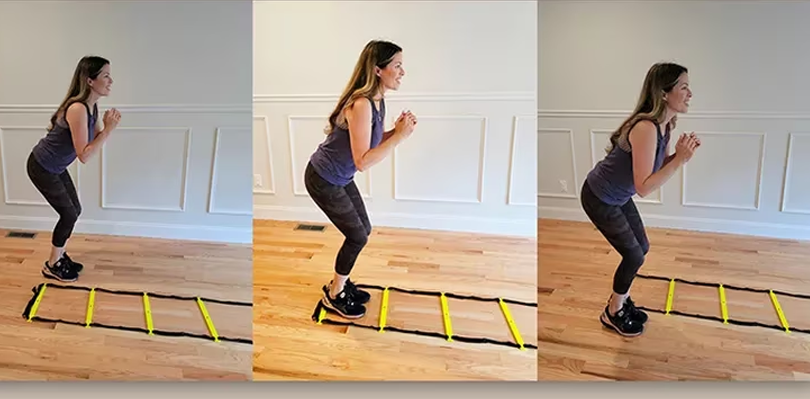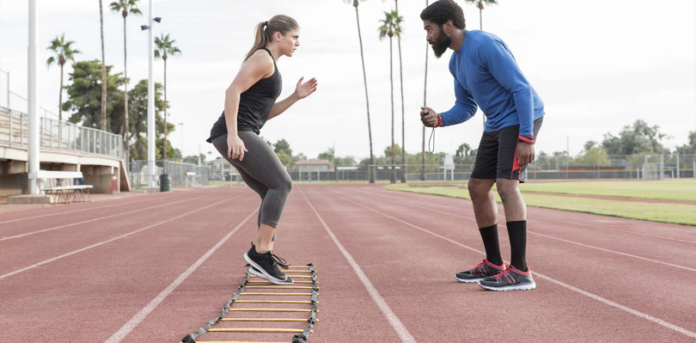If you’re looking to enhance your speed, strength, and overall athleticism, you’ve come to the right place. In this blog post, we will unveil the seven best agility exercises that will revolutionize your training routine and help you achieve peak performance.
Agility is a crucial component of any athletic activity, from sports like soccer and basketball to everyday tasks that require quick movements. By incorporating these exercises into your workout regimen, you’ll not only enhance your agility but also develop explosive power, coordination, and flexibility.
Whether you’re an athlete looking to improve your performance on the field or someone seeking to elevate your fitness level, these exercises cater to all skill levels and goals. From ladder drills that challenge your footwork to cone drills that enhance your change of direction, each exercise is specifically designed to optimize your speed and strength. Prepare to unlock your full potential and become a force to be reckoned with. Let’s dive into the seven best agility exercises that will transform your athleticism and take your fitness journey to new heights.
What Are Agility Exercises
Agility exercises are specific physical activities designed to improve an individual’s ability to change direction, accelerate, decelerate, and maintain control while performing dynamic movements. These exercises focus on enhancing agility, which is a combination of speed, coordination, balance, and reaction time. Agility drills often involve quick footwork, lateral movements, changes of direction, and spatial awareness.
Examples of agility exercises include ladder drills, cone drills, shuttle runs, box jumps, and T-drills. By incorporating agility exercises into a training regimen, individuals can enhance their athletic performance, reduce the risk of injuries, and excel in sports or activities that require quick and efficient movements.
Best Agility Exercises

Here are some of the best agility exercises along with some extra details about each exercise:
Ladder Drills
Ladder drills are a series of footwork exercises performed on a ladder-shaped mat. They challenge your speed, coordination, and agility by requiring quick and precise movements between the ladder rungs. Popular ladder drills include high knees, lateral hops, and in-and-out drills.
Cone Drills
Cone drills involve setting up a series of cones in various patterns and performing quick changes of direction around them. These drills improve your ability to accelerate, decelerate, and change direction rapidly. Examples of cone drills include the 5-10-5 shuttle run and the T-drill.
Agility Hurdles
Agility hurdles are small, adjustable hurdles that can be used to develop quickness and explosive power. You can perform exercises like lateral jumps over hurdles, forward/backward jumps, and single-leg hops to enhance your agility and leg strength.
Shuttle Runs
Shuttle runs are excellent for improving both speed and agility. They involve sprinting back and forth between two points, changing direction quickly at each end. Shuttle runs can be customized with different distances and patterns to simulate game-like situations.
Box Jumps
Box jumps are plyometric exercises that enhance lower-body power and explosiveness. By jumping onto a sturdy box or platform from a standing position, you activate your leg muscles and develop the ability to generate force quickly. Start with a lower box height and gradually increase the challenge as you progress.
T-Drills
T-drills are a combination of sprinting and change-of-direction exercises. They require you to run forward, touch a cone, and then change direction to sprint to another cone. T-drills mimic the movement patterns involved in many sports and improve your agility, speed, and reaction time.
Agility Ladder Shuffle
This exercise involves shuffling laterally through an agility ladder, moving your feet quickly in and out of the ladder rungs. The agility ladder shuffle improves your footwork, balance, and coordination while targeting your hip and leg muscles.
Incorporating these seven agility exercises into your training routine will not only boost your speed and strength but also enhance your overall athletic performance. Remember to start with proper warm-up exercises, maintain good form, and gradually increase the intensity and difficulty level as you progress. Get ready to elevate your agility and dominate any physical challenge that comes your way!
Benefits Of Agility Exercises
Improved Speed
Agility exercises challenge the body to move quickly and efficiently, enhancing overall speed and acceleration. By training the muscles to respond rapidly to changing stimuli, athletes can achieve faster sprint times and improved on-field performance.
Enhanced Reaction Time
Agility exercises require swift reactions to various cues and obstacles. This type of training sharpens neural pathways and cognitive processing, leading to quicker reaction times both on and off the field.
Increased Coordination
Agility drills involve complex movements that demand precise coordination between different body parts. Regular practice improves motor skills, hand-eye coordination, and overall body control, which is invaluable in sports and daily activities.
Greater Flexibility
Agility exercises often incorporate dynamic stretching and movement patterns, promoting better flexibility. This flexibility not only reduces the risk of injury but also enables athletes to achieve a wider range of motion during explosive movements.
Strengthened Muscles
Many agility exercises are plyometric in nature, focusing on explosive movements that engage multiple muscle groups. As a result, athletes develop greater strength, power, and muscular endurance, benefiting their overall athletic performance.
Injury Prevention
Improved agility and body control lead to better joint stability and balance, reducing the likelihood of injuries. Athletes who regularly perform agility exercises are better equipped to navigate uneven terrain and sudden changes in direction without compromising their stability.
Sport-Specific Performance
Agility exercises can be tailored to mimic the movements and demands of specific sports, making them highly transferable to on-field performance. Athletes can improve their sport-specific skills, such as cutting, dodging, and lateral movements, through targeted agility training.
In conclusion, incorporating agility exercises into a fitness routine offers numerous benefits, ranging from increased speed and strength to enhanced coordination and injury prevention. Athletes and fitness enthusiasts alike can optimize their performance and reach new levels of athleticism by integrating these dynamic drills into their training regimen.
5 Things To Avoid During Agility Exercises
Poor Technique
It’s crucial to maintain proper form and technique during agility exercises. Avoid sloppy movements, incorrect footwork, and improper body positioning, as they can increase the risk of injury and diminish the effectiveness of the exercise. Focus on executing each movement with precision and control.
Overtraining
While agility exercises are beneficial, overtraining can lead to fatigue, decreased performance, and increased risk of injury. Allow for adequate rest and recovery between sessions to give your body time to repair and adapt. Listen to your body and avoid pushing yourself beyond your limits.
Insufficient Warm-Up
Skipping or rushing through a warm-up is a common mistake. Always dedicate enough time to warm up your muscles and prepare your body for the demands of agility exercises. A proper warm-up increases blood flow, improves flexibility, and reduces the chance of strains or pulls.
Neglecting Strength Training
While agility exercises focus on speed and agility, it’s important not to neglect strength training. Building a solid foundation of strength helps support the joints, improves overall power output, and reduces the risk of imbalances or weaknesses. Incorporate strength exercises such as squats, lunges, and plyometrics into your routine.
Ignoring Recovery And Stretching
Recovery and stretching are often overlooked but essential components of any training program. Neglecting these aspects can lead to muscle imbalances, decreased flexibility, and increased risk of injury. Incorporate proper cool-down exercises and stretching routines to promote muscle recovery and maintain flexibility.
By avoiding these common mistakes, you can maximize the benefits of agility exercises, minimize the risk of injury, and optimize your speed and strength gains. Remember to prioritize proper technique, listen to your body, and give yourself the necessary time for rest and recovery.
FAQs
Are agility exercises suitable for beginners?
Yes, agility exercises can be adapted for individuals of different fitness levels, including beginners. It’s important to start with exercises that match your current abilities and gradually progress as you become more comfortable and proficient. Beginners may begin with basic ladder drills, cone drills, and shuttle runs, focusing on proper form and technique. As you build strength, coordination, and confidence, you can gradually introduce more challenging exercises. Consulting a fitness professional or trainer can help create a customized program that suits your needs and abilities.
Can agility exercises help with weight loss?
Agility exercises can contribute to weight loss by incorporating high-intensity movements that burn calories and improve overall fitness. These exercises promote cardiovascular endurance, increase muscle engagement, and boost metabolism. When combined with a balanced diet and overall exercise routine, these workouts can be a valuable component of a weight loss program. Additionally, it can help develop lean muscle mass, which aids in burning calories even at rest. Remember, for effective weight loss, it’s important to create a calorie deficit through a combination of exercise and proper nutrition.
Are agility exercises only beneficial for athletes?
No, agility exercises offer benefits beyond the realm of sports and are suitable for individuals of various backgrounds and fitness goals. While athletes can significantly enhance their performance in sports that require quick movements, these exercises also improve general fitness attributes such as speed, coordination, balance, and reaction time. They can be incorporated into diverse training programs, including weightlifting, circuit training, or general fitness routines. Additionally, these exercises enhance overall body awareness and reduce the risk of injuries, making them valuable for individuals seeking improved fitness and functionality in their daily lives.

